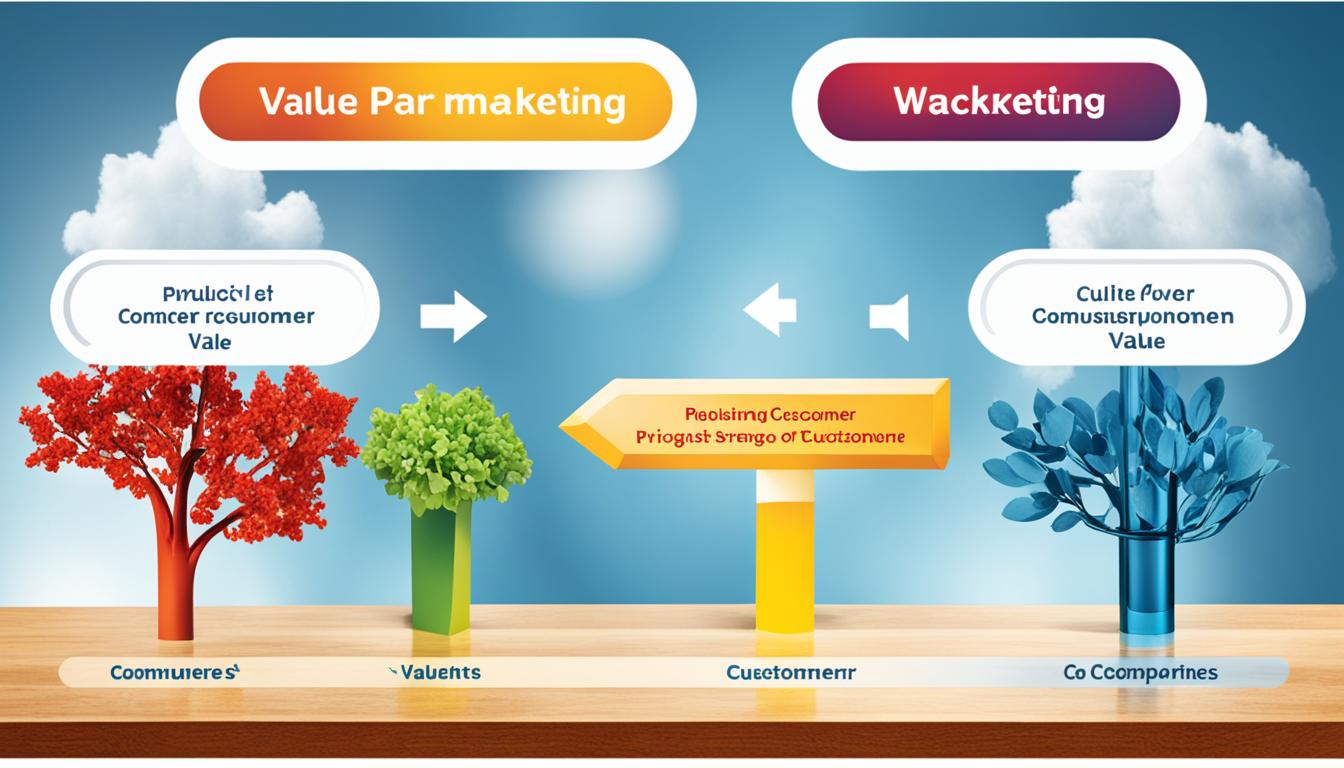Selective marketing is a powerful strategy that allows businesses to precisely target specific market segments, reducing marketing costs and maximizing return on investment. By employing audience segmentation and customer targeting, businesses can tailor their marketing efforts to reach the most valuable customers and achieve higher profits.
Unlike traditional undifferentiated marketing, which aims to reach a broad audience, selective marketing focuses on niche markets and specific customer segments. This approach is particularly effective for small businesses with limited resources or specialty products designed for specific markets.
In selective marketing, companies employ market segmentation techniques to identify the most promising market segments and tailor their marketing messages accordingly. By understanding the unique needs and preferences of these segments, businesses can create personalized marketing campaigns that resonate with their target audience.
For example, luxury retailers adopt selective marketing strategies to target a limited segment of the population that can afford their high-end products. They invest in selective campaigns, such as glossy ads in lifestyle magazines and TV spots during events that attract a high-income crowd. This targeted approach ensures that the luxury message reaches the right consumer, increasing the chances of generating sales.
Similarly, specialty product manufacturers rely on selective marketing to reach specific professional or niche markets. They may advertise in industry-specific journals, participate in relevant events, and use tailored marketing techniques to raise awareness among interested parties. This focused strategy allows them to connect with their target audience and drive sales.
While selective marketing offers many advantages, such as cost-effectiveness and increased customer loyalty, it also carries some risks. The precise nature of selective marketing may limit flexibility, making it challenging to adapt to changes in consumer trends or alterations in the target market. Small businesses should carefully consider these factors and be prepared to adjust their marketing strategies accordingly.
In conclusion, selective marketing is a valuable tool for businesses seeking to optimize their marketing efforts. By targeting specific market segments, businesses can reduce marketing costs, improve customer loyalty, and achieve higher profits. By understanding the examples and strategies discussed, businesses can implement selective marketing effectively and drive long-term success.
Key Takeaways:
- Selective marketing targets specific market segments, reducing marketing costs and increasing return on investment.
- It involves audience segmentation and customer targeting to tailor marketing messages to the most valuable customers.
- Selective marketing is effective for small businesses with niche markets and specialty products.
- Luxury retailers use selective marketing to target a high-income audience through specific advertising channels.
- Specialty product manufacturers employ selective marketing to reach specific professional or niche markets.
The Purpose of Selective Marketing
The purpose of selective marketing is to maximize the best-performing market segment for a small business. By focusing all marketing initiatives on a single goal, small businesses can achieve the highest return on their marketing investment. This strategy is especially beneficial for businesses with niche markets or those who know their customers well.
Undifferentiated marketing, which targets the entire market with a single marketing strategy, can be costly and ineffective for small businesses. Instead, selective marketing allows businesses to identify specific market segments that have the greatest potential for success. By tailoring marketing efforts to these segments, small businesses can optimize their resources and increase their chances of reaching target customers.
In a niche market, where the target audience is well-defined and distinct, selective marketing becomes even more important. By understanding the unique needs and preferences of the niche market, businesses can develop highly targeted marketing campaigns that resonate with their customers. This approach helps establish a strong connection with the target audience, leading to increased brand awareness, customer loyalty, and ultimately, higher sales.
To implement selective marketing effectively, businesses need to conduct thorough market research and segmentation analysis. It is essential to identify the specific market segment with the highest potential for profitability and tailor marketing initiatives accordingly. By focusing resources on these target segments, businesses can create personalized messaging and offers that directly address the needs and desires of the target audience.
Marketing initiatives can take various forms, such as digital advertising, social media campaigns, content marketing, email marketing, and targeted promotions. The key is to ensure that every marketing effort is aligned with the characteristics and preferences of the target market segment. By doing so, small businesses can maximize the impact of their marketing investment and achieve sustainable growth.
Here is a comprehensive table illustrating the key differences between undifferentiated marketing and selective marketing:
| Undifferentiated Marketing | Selective Marketing |
|---|---|
| Targets the entire market | Focuses on specific market segments |
| One-size-fits-all marketing strategy | Precision-tailored marketing campaigns |
| High marketing costs due to broad targeting | Reduced marketing costs by targeting specific segments |
| Less personalized messaging and offers | Highly targeted messaging and personalized offers |
| May overlook the unique needs of different segments | Addresses the specific needs of each targeted segment |
| Limited customer engagement and brand loyalty | Enhanced customer engagement and brand loyalty |
The Benefits of Selective Marketing
Selective marketing offers several benefits for small businesses:
- Maximizes the return on marketing investment by focusing on the most profitable market segment
- Allows businesses to tailor marketing initiatives to the specific needs and preferences of the target audience
- Increases brand awareness and customer loyalty through personalized messaging and offers
- Reduces marketing costs by eliminating wasteful efforts on non-relevant market segments
- Improves overall marketing effectiveness and efficiency
Selective Marketing for Luxury Goods
Luxury retailers often rely on selective marketing to target a limited segment of the population. This approach ensures that the right message reaches the right consumer, increasing sales. For example, luxury retailers might use glossy ads in lifestyle magazines and TV spots that run during events that attract a high-income crowd. This targeted approach saves time and resources by avoiding wasted efforts on the general public.
Examples of Selective Marketing for Luxury Goods
Let’s take a look at some real-world examples of how luxury retailers use selective marketing strategies to reach their target audience:
| Luxury Retailer | Selective Campaign | Target Consumer |
|---|---|---|
| Tiffany & Co. | Glossy ads in high-end lifestyle magazines | High-income individuals interested in luxury jewelry |
| Rolex | Prime-time TV spots during major sporting events | Watch enthusiasts with a high spending power |
| Chanel | Sponsorship of exclusive fashion events | Aspiring fashionistas and affluent clientele |
By carefully selecting the channels and platforms, luxury retailers can effectively cater to their target consumers and create a sense of exclusivity around their brand. This focused approach ensures that their marketing efforts are more likely to resonate with their high-income audience, driving sales and brand loyalty.
Selective Marketing for Specialty Products
Specialty products designed for specific professional or niche markets require selective marketing strategies. These products cater to a limited number of potential customers, making it crucial to tailor marketing efforts to meet the specific needs and desires of the target audience. To effectively promote specialty products, businesses often utilize a combination of strategies including advertising in industry-specific journals, participating in collectibles events, and employing general advertising techniques to raise awareness among interested parties.
Advertising in industry-specific journals is an effective way to reach professionals within the target market. By placing relevant and engaging ads in pilot journals or other publications specific to the professional market, businesses can capture the attention of their desired audience. These journals often have a dedicated readership that includes decision-makers and influential individuals within the industry, providing an excellent opportunity to showcase specialty products to a receptive audience.
Participating in Collectibles Events
Another effective strategy for marketing specialty products is by participating in collectibles events or trade shows. These events attract individuals who are passionate about their niche interests, creating a unique opportunity to showcase and sell specialty products directly to the target market. By exhibiting at these events, businesses can interact with potential customers, generate leads, and build brand awareness within the niche market.
Furthermore, general advertising techniques can also be employed to raise awareness among individuals who may have an interest in specialty products. While these techniques may have a broader reach and may not specifically target the niche market, they can help create brand recognition and generate interest. For example, businesses can utilize social media platforms, content marketing, or influencer partnerships to reach a wider audience and direct them to specialized channels.
Specialty Products Marketing Strategies:
| Marketing Strategy | Description |
|---|---|
| Advertising in industry-specific journals | Placing ads in pilot journals or other relevant publications to target professionals and individuals within the niche market. |
| Participating in collectibles events | Showcasing specialty products at trade shows and events specifically tailored to the target market. |
| Utilizing general advertising techniques | Employing broader marketing methods such as social media, content marketing, and influencer partnerships to generate interest among a wider audience. |
In conclusion, marketing specialty products for professional or niche markets requires a strategic and targeted approach. By utilizing a combination of advertising in industry-specific journals, participating in collectibles events, and employing general advertising techniques, businesses can effectively reach their desired audience and create awareness for their specialty products.
Problems with Selective Marketing
While selective marketing can yield excellent results when conditions are favorable, it carries the risk of being vulnerable to changes in consumer trends or alterations in the target market. This strategy’s precise nature may limit flexibility and make it challenging to adapt when needed. Small businesses must consider the potential risks and be prepared to adjust their marketing strategies accordingly.
| Challenges | Solutions |
|---|---|
| 1. Changes in consumer trends | Stay updated on consumer behavior and conduct regular market research to identify shifting trends. Adapt marketing strategies to align with evolving consumer preferences. |
| 2. Alterations in the target market | Monitor market conditions and demographics to identify any shifts in the target market. Adjust marketing messages and tactics to better resonate with the changing consumer base. |
| 3. Limited flexibility | Balance precise targeting with the ability to pivot when necessary. Maintain a deep understanding of the market and consumer needs to facilitate quick adjustments to marketing strategies. |
| 4. Adapting to unforeseen circumstances | Develop contingency plans to account for unforeseen circumstances that may impact marketing efforts. Stay agile and ready to make adjustments as needed. |
Importance of Addressing Problems
Addressing the potential problems with selective marketing is crucial for small businesses. By recognizing the challenges and finding effective solutions, businesses can mitigate risks and ensure the longevity of their marketing strategies. Flexibility and adaptability are key in navigating the dynamic landscape of consumer trends and ever-changing target markets.

Understanding Selective Distribution
Selective distribution is a channel distribution strategy that allows companies to strategically choose specific outlets to make their products available to consumers. This approach involves carefully selecting outlets based on their potential profits and ability to effectively sell the company’s offerings. By focusing on these key factors, companies can maximize their profitability through targeted and efficient distribution.
In selective distribution, companies have some flexibility in terms of the products that outlets stock. However, the primary objective remains to ensure that the chosen outlets are capable of delivering the desired results. This strategy involves analyzing various profitability parameters, such as sales potential, customer reach, and market demand, to identify the most suitable outlets for stocking and selling the products.
By selecting outlets that align with the company’s distribution goals, businesses can enhance their chances of success and profitability. These outlets may include retail stores, online platforms, or specialized distribution channels that cater to specific customer segments. The ultimate aim is to leverage the strengths and capabilities of the chosen outlets to drive sales and meet consumer demand effectively.
To provide a better understanding of selective distribution, let’s consider the following example:
| Brand | Outlet Type | Location | Target Market |
|---|---|---|---|
| Zara | Company-owned stores | Global | Youthful and trend-conscious consumers |
| Raymond | Franchise and selective outlets | Multiple countries | Quality-conscious buyers |
| Louis Vuitton | Luxury boutiques | Exclusive locations | High-end luxury consumers |
In the fashion industry, selective distribution strategies are commonly used. Brands like Zara predominantly sell their products through their own company-owned stores. This allows them to maintain control over the brand experience while catering to their target market of youthful and trend-conscious consumers.
On the other hand, Raymond, a renowned clothing brand, employs a mix of franchise outlets and selective distribution channels. This strategy enables them to expand their reach by partnering with independent retailers while also maintaining selective control over distribution. Raymond’s target market consists of quality-conscious buyers seeking premium clothing options.
Luxury brands like Louis Vuitton take selective distribution to the next level by establishing exclusive luxury boutiques in prime locations. These select outlets provide an ultra-premium shopping experience for high-end luxury consumers who prefer exclusivity and personalized service.
By implementing selective distribution strategies, businesses can precisely target their desired customer segments, streamline their distribution processes, and increase their potential for profitability.
Strategy behind Selective Distribution
Companies that aim to have more control over their distribution channels and ensure greater visibility for their brand often opt for selective distribution. This strategy allows companies to strategically choose outlets that align with specific locations or price points, enabling them to target their products effectively to specific consumer segments. Selective distribution strikes a delicate balance between exclusivity and accessibility, offering companies the opportunity to reach their target audience precisely.
Advantages of Selective Distribution
Selective distribution offers several advantages for companies:
- Improved brand visibility in targeted locations.
- Increased exclusivity, creating a perception of higher value and desirability.
- Enhanced control over the distribution process, ensuring the brand’s image and reputation are consistently upheld.
- Better alignment between the brand and the outlets, leading to more effective marketing efforts.
Challenges of Selective Distribution
While selective distribution provides significant benefits, it is not without challenges:
- Reduced market coverage due to the limited number of outlets.
- Higher initial investment required to establish and maintain a selective distribution network.
- Potential resistance from non-selected retailers who may feel excluded from the distribution network.
- Difficulty in expanding market penetration beyond the selected consumer segments.
| Advantages | Challenges |
|---|---|
| Improved brand visibility | Reduced market coverage |
| Increased exclusivity | Higher investment required |
| Enhanced control over the distribution process | Potential resistance from non-selected retailers |
| Better alignment between the brand and the outlets | Difficulty in expanding market penetration |

By strategically implementing selective distribution, companies can leverage the benefits of targeted visibility and exclusivity while overcoming the associated challenges. This approach allows businesses to optimize their distribution efforts and effectively reach the desired consumer segments, driving sales and brand success.
Advantages and Disadvantages of Selective Distribution
Selective distribution provides numerous advantages that contribute to a more efficient and effective marketing strategy. Firstly, it allows for a more targeted market coverage, ensuring that products are available in locations where the target audience is concentrated. By focusing on specific outlets and regions, businesses can optimize their market reach and allocate resources more efficiently.
Moreover, selective distribution contributes to improved consumer satisfaction. By carefully selecting outlets that cater to the specific needs and preferences of the target market, businesses can enhance the overall customer experience. This leads to higher levels of customer satisfaction and loyalty, as consumers can easily access their preferred products through convenient channels.
Selective distribution also fosters improved communication between manufacturers and outlets. By working closely with a limited number of distributors, manufacturers can establish stronger partnerships and ensure better alignment between their marketing objectives and the outlets’ strategies. This facilitates the exchange of valuable market insights, feedback, and information, enabling manufacturers to make informed decisions and adapt their marketing activities accordingly.
However, it is important to consider the limitations of selective distribution. One significant disadvantage is the limited market penetration that comes with focusing on a restricted number of outlets. While this strategy ensures concentrated efforts within selected market segments, it also means that potential customers outside of these areas may not have access to the products or be aware of their existence.
To illustrate the advantages and disadvantages of selective distribution more comprehensively, consider the following table:
| Advantages | Disadvantages |
|---|---|
| Targeted market coverage | Limited market penetration |
| Improved consumer satisfaction | |
| Enhanced communication |
While selective distribution offers numerous benefits, such as targeted market coverage, enhanced consumer satisfaction, and improved communication between manufacturers and outlets, it is essential for businesses to consider the potential downsides, particularly limited market penetration. By carefully evaluating the advantages and disadvantages, businesses can make informed decisions and tailor their distribution strategies to maximize their overall marketing effectiveness.
Examples of Selective Distribution
Selective distribution is not limited to a single industry but can be observed in various sectors. Let’s explore how selective distribution is applied in the automotive, clothing, and watch industries.
Automotive Sector
In the automotive industry, different brands adopt various distribution strategies based on their positioning and target audience. Luxury car brands often choose to adopt an exclusive distribution model, where their vehicles are only available through select dealerships. This approach creates an air of exclusivity and enhances the brand’s image among high-end consumers. On the other hand, premium or mid-range car brands typically employ a selective distribution strategy. This allows them to carefully select authorized dealerships that align with their target market, ensuring their vehicles are available where their prospective customers are most likely to be.
Clothing Brands
The clothing industry offers another example of selective distribution. Clothing brands like Zara, known for their fast-fashion approach, adopt an exclusive distribution model by selling their products exclusively through their stores and online channels. This helps them maintain control over their brand image, pricing, and availability of products. Other clothing brands, such as Raymond, follow a mix of selective and franchise outlets. They strategically choose select partners to expand their distribution network while ensuring their brand’s integrity remains intact.
The Watch Industry
In the watch industry, brands like Titan employ selective distribution to categorize their products and target specific consumer segments. They carefully choose authorized dealerships to ensure their watches are accessible to their target audience. This approach allows them to offer a personalized shopping experience and maintain a consistent brand image. By employing selective distribution, watch brands can effectively reach customers who value quality, craftsmanship, and exclusivity.
Conclusion
Selective marketing and distribution strategies offer businesses a cost-effective way to not only optimize their marketing efforts but also target their most valuable customers. By focusing on specific market segments, businesses can reduce unnecessary costs and improve customer loyalty. Selective retention ensures that companies allocate their resources wisely by prioritizing profitable customers and avoiding wasteful spending on less valuable ones.
Implementing selective marketing and distribution strategies effectively can lead to higher profits and long-term success. By tailoring their marketing campaigns to specific market segments, businesses can create personalized and targeted messages that resonate with their audience, increasing the likelihood of conversion and customer loyalty. Furthermore, these strategies enable companies to allocate resources efficiently and make more informed decisions about their marketing investments.
In today’s highly competitive business landscape, understanding the importance of selective marketing and distribution is crucial. By identifying and targeting valuable customers, businesses can streamline their marketing efforts and ensure a higher return on investment. Selective retention allows companies to focus their resources on customers who are most likely to generate revenue and count as valuable assets to the business. By employing selective marketing and distribution strategies, companies can build customer loyalty and position themselves as industry leaders.
FAQ
What is selective marketing?
Selective marketing is a strategy that involves targeting specific market segments to maximize return on investment and minimize marketing costs.
What is the purpose of selective marketing?
The purpose of selective marketing is to focus marketing initiatives on the best-performing market segment for a small business and achieve the highest return on investment.
How is selective marketing used for luxury goods?
Luxury retailers use selective marketing to target a limited segment of the population by employing strategies like glossy ads in lifestyle magazines and TV spots during high-income events.
How is selective marketing used for specialty products?
Specialty products designed for specific professional or niche markets require selective marketing strategies, which involve advertising in industry-specific journals and participating in relevant events.
What are the problems with selective marketing?
The precise nature of selective marketing may limit flexibility and make it challenging to adapt to changes in consumer trends or alterations in the target market.
What is selective distribution?
Selective distribution is a channel distribution strategy where a company selects specific outlets to make its products available to consumers based on potential profits and the outlets’ ability to sell effectively.
What is the strategy behind selective distribution?
Selective distribution allows companies to have more control over their distribution channels, strike a balance between exclusivity and accessibility, and target their products to specific consumer segments effectively.
What are the advantages and disadvantages of selective distribution?
The advantages of selective distribution include more targeted market coverage, improved consumer satisfaction, and better communication between manufacturers and outlets. However, the limited number of outlets may result in limited market penetration.
Can you provide examples of selective distribution?
Examples of industries using selective distribution include the automotive sector, clothing brands, and the watch industry, where luxury and mid-range brands employ this strategy to target specific consumer segments.
What is the conclusion of selective marketing and distribution?
Selective marketing and distribution help businesses optimize their marketing efforts and target the most valuable customers, resulting in higher profits and long-term success.







